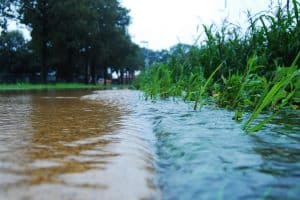Stormwater is water that used to soak into the ground and become ground water prior to development but runs off of impervious surfaces, collecting pollutants until it ultimately enters our surface waters. These pollutants include trash, chemicals, sediment, and oils among many others. Stormwater runoff is usually not treated prior to discharge, so these pollutants are directly inputted into local waters. Population growth and development rates are increasing the amount of pollutions and the volume and rate of runoff from impervious surfaces. Stormwater runoff pollution causes changes in hydrology and water quality that then result in habitat modifications, increased flooding, decreased aquatic biological diversity, and increased sedimentation and erosion. Best management practices (BMPs) like bioretention areas filter out pollutants and/or prevent pollution by controlling it at its source.
Urbanized areas affect water quality in a multitude of ways from a stormwater perspective, mainly by increasing runoff volumes and pollutant loads. The terrain of natural landscapes is rough and uneven, allowing it to trap rainwater and slowly release filtered stormwater into the groundwater reservoirs. Development reduces the amounts of natural landscapes, replacing them with smooth impervious surfaces. This produces larger amounts of faster moving runoff. To combat this issue, m any urbanized areas created storm sewer systems to capture the runoff and deliver it to local waterbodies “safely.” Storm sewers, however, concentrate runoff in underground pipes, allowing it to gain speed and erosional force as it travels towards our surface waters. So when the storm sewer system empties directly into the stream, the water is so fast and warm that it can blast out stream banks, damage streamside vegetation, reduce aquatic habitat, and harm aquatic life. The impervious nature of development also negatively affects groundwater levels. During wet periods, urban areas typically experience great increases in flooding, but during dry periods, stream flow levels are often lower. Overall, runoff from urbanized areas proves very harmful to aquatic ecosystems.
any urbanized areas created storm sewer systems to capture the runoff and deliver it to local waterbodies “safely.” Storm sewers, however, concentrate runoff in underground pipes, allowing it to gain speed and erosional force as it travels towards our surface waters. So when the storm sewer system empties directly into the stream, the water is so fast and warm that it can blast out stream banks, damage streamside vegetation, reduce aquatic habitat, and harm aquatic life. The impervious nature of development also negatively affects groundwater levels. During wet periods, urban areas typically experience great increases in flooding, but during dry periods, stream flow levels are often lower. Overall, runoff from urbanized areas proves very harmful to aquatic ecosystems.
Urban development contributes significantly to increased amounts and varieties of pollutants in stormwater runoff. Typical urban pollutants include: “sediment; oil, grease, and toxic chemicals from motor vehicles; pesticides and nutrients from lawns; viruses, bacteria, and nutrients from pet waste and failing septic systems; road salts; heavy metals from roof shingles, motor vehicles, etc.; and thermal pollution from dark impervious surfaces.” As these sources become more ubiquitous, higher amounts of these pollutants are captured by stormwater and deposited into our waterbodies.
Luckily, stormwater management practices can combat these negatives effects of urbanization by filtering and/or treating stormwater runoff at the source. Some benefits of stormwater management include “protection of wetlands and aquatic ecosystems, improved quality of receiving waterbodies, conservation of water resources, protection of public health, [and] flood control.” Stormwater management can be conducted at the household/property or community level.
Homeowners can help reduce the amounts of stormwater leaving their properties and the pollutants it carries with it. Using alternatives to traditionally impervious surfaces like permeable pavement can reduce the amount of runoff leaving the property by still creating a functional surface while allowing treated runoff to infiltrate into the ground. Practices like Integrated Pest Management (IPM) reduce chemical and water usage on your lawn. Creating a landscape utilizing native vegetation and mulch reduces the impacts on our stormwater from high maintenance lawns. Sweeping sidewalks, driveways, and other paved surfaces instead of washing them with a hose further reduces the amount of runoff leaving your property. Regular inspection for leaks in your cars and using car washing facilities with sanitary sewer connections that do not produce run off can help keep harmful chemicals out of our stormwater as well. Recycling compounds like motor oil and antifreeze has a number of environmental benefits as well. Even small practices like switching your cleaning methods can have big impacts on our waterways.
Many communities’ stormwater pollution prevention plans emphasize reducing urban runoff from both new and existing development. New developments are easier to incorporate stormwater management BMPs into because there are few existing complications present on site. Stormwater management on new developments focuses on reducing runoff volumes through pollution prevention strategies, structural controls, and low impact development (LID). LID emphasizes the conservation of natural areas, reduction of development impacts, and maximization of surface roughness, infiltration rates, and flow paths. Stormwater management on existing developments is often more costly, and thus these retrofits focus on targeting “hot spots” and using techniques with multiple benefits. Stormwater management efforts should always include outreach components to inform community members and hopefully recruit others in our efforts to maintain clean waterways.
For more information on stormwater, stormwater management, or community stormwater management plans, contact Tinker’s Creek Watershed Partners. The information in this article was obtained from US EPA’s “Protecting Water Quality from Urban Runoff,” which can be viewed by clicking here.

